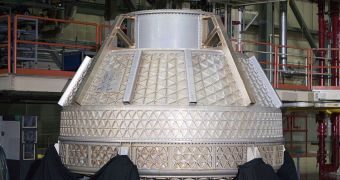On Friday, March 9, engineers at Pratt & Whitney Rocketdyne, in the United States, conducted a successful test of a new rocket thruster. The motor will be used as a Launch Abort System (LAS) on the CST-100 spacecraft, which the Boeing Company is developing under a contract with NASA.
The corporation is receiving funds from the American space agency under the NASA Commercial Crew Development Round 2 (CCDev2) program, and has sub-contracted Pratt & Whitney to develop the LAS for its unmanned space capsule, called CST-100.
The vehicle will primarily be used to ferry cargo to the International Space Station (ISS). There are certain plans to turn it into a manned spacecraft in time, but Boeing is focusing on having its capsule ready to go as soon as possible.
NASA is currently dependent on the Russian Federal Space Agency (RosCosmos) for access to the ISS, and is delivering its cargo to orbit via Russian, European or Japanese space capsules. This situation is precisely why the CCDev2 program was set up.
Thanks to the success of the March 9 tests, Boeing has achieved yet another of the milestone listed in the Space Act Agreement (SSA) under which it is receiving NASA funding. When converted to a manned spacecraft, the Crew Space Transportation capsule will be able to carry 7 astronauts to space.
“Boeing and its contractor, Pratt & Whitney Rocketdyne, continue to make good progress on milestones supporting the development of their commercial crew transportation capabilities,” explains the NASA Commercial Crew Program program manager, Ed Mango.
“The eventual availability of these capabilities from a US domestic provider will enhance US competitiveness and open new markets for the US aerospace industry,” the official goes on to say.
The purpose of the LAS is to ensure that a spacecraft can be safely whisked away from atop its carrier rocket, in case an anomaly or accident occurs. The LAS thrusters immediately separate the capsule from the delivery system, and accelerate it at great velocity to safety.
“We achieved full thrust on the 40,000-pound thrust-class engine while validating key operating conditions during engine start-up and shut down,” explains Pratt and Whitney Rocketdyne's Commercial Crew Development program manager, Terry Lorier.
“The tests provided key thermal and analytical data. We are well on our way to providing an important propulsion system for safe, reliable human spaceflight,” the expert concludes.

 14 DAY TRIAL //
14 DAY TRIAL //